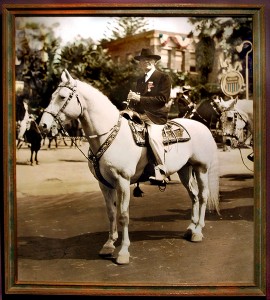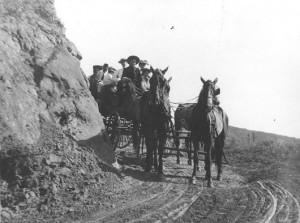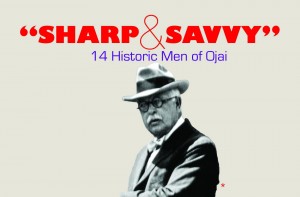Sharp & Savvy: The Clark Brothers
By David Mason
Perhaps the greatest testament to the bravery of the two Clark brothers was written by Henry Sparks in his account of the Ojai Fire of 1917.
“When Tom Clark arrived from his duties at the Courthouse,…he first organized a bucket brigade, sending for all the washtubs in town, then ordered barley sacks and designated certain dependable men to mount the houses with shingled roofs and beat out any blaze there. In this manner, the Pratt House was saved but the Foothills Hotel, lost, as the caretaker would not allow the men a ladder to mount the roof. …As the fire burned itself out, the men rushed to the business section. They only succeeded in saving Tom’s home by the narrowest of margins, losing the second story altogether. Tom continued to fight fire through the night. …In the meantime, Bob and the rest of the Clark family, including the women, were out fighting the flames to save homes between the town and the Thacher School. …Let me repeat what I heard John Lagomarsino tell N.B. Smith, ‘About a dozen of us stayed on the roofs of these buildings for two hours with wet sacks and pails of water. Ten different times the roofs took fire and sometimes in two or three places at a time. …I never saw a man work so hard and use his head so well as Bob Clark did that night. He was badly burned about the face and arms….’ Is it any wonder that the entire Clark family is highly regarded in the Ojai Valley and throughout the entire county?”
Thomas S. Clark (1865 – 1940)
Tom Clark arrived in the Ojai Valley in 1881, along with his mother and six siblings, after his father, Michael, had sent for the family to join him. Michael had commuted back and forth from Wisconsin to the Ojai Valley since 1868, the year his brother had settled in the Upper Ojai.
On his arrival, “red-haired Tommy” convinced the local stage line that he, at 16 years of age, was capable of driving stage for the handsome sum of $30 a month. Before long, he was considered the only driver capable of delivering passengers to Ventura during the valley’s periodic torrential rain storms.
In 1894, he and his brother Will, opened the Clark Brothers Stage Line, charging $1 for trips from Nordhoff to Ventura, and charging 50 cents apiece for luggage.
By 1903, Tom, then married and the father of five, was recognized as “one of the most prominent business factors” in the Ojai by the Ventura Democrat newspaper. The following year, he purchased a home, which was the former Oak Cottage rooming house on the S.E. corner of Signal and Matilija Streets.
It was a proud moment for Tom when he, the son of Irish famine immigrants, was invited to serve as a founding member of the Committee of Fifteen, “pledged to enforce the law, preserve order and promote good citizenship” in the valley.

On November 8, 1904, Tom was elected Supervisor for the 3rd District, County of Ventura, a position he held until 1932. As Supervisor, his main responsibility was facilitating transportation throughout the county-many roads and bridges were built as the result of his determination and political skill.
As a member of the Ventura County Fair Board, Tom suggested that Chariot Races be introduced as an attraction after said races were abandoned by the Rose Bowl as being too dangerous. Tom, himself, was happy to drive year after year, breaking the world record for four-abreast chariot racing in 1926, an event notable enough to be mentioned in the Boston Globe, and, as reported by The Ojai; “the garl darndest, air-splittingest, bloodcurdlingest chariot races ever staged on the Pacific Coast.”
Editor Frank Kilbourne of The Ojai wrote of Tom on his death, “He was that dearly prized and rare man, a public official whose honesty never was questioned; he served without thought of personal gain or advancement.”
Helen Robertson proposed that a permanent memorial be constructed to honor Tom. Today, that horse trough resides in Rotary Community Park with the original inscription stone:
TO TOM CLARK
BUILT BY HIS FRIENDS TO HONOR A GREAT
HORSEMAN FOR HIS MANY YEARS OF SERVICE TO THE
OJAI VALLEY
Robert Emmet “Bob” Clark
Tom Clark’s youngest brother, Bob, worshipped his elder brother as only an irreverent younger brother can do, emulating his brave deeds and always attempting to outdo them. While both were expert horseman, masters of the “six-in-hand,” Tom was small and compact, reserved, calm, and self-contained, while Bob was tall, rangy, bold, brave, and never met a stranger. Both, however, were distinguished by their red hair and their love for the Ojai Valley.

Bob drove stage for Tom during his youth, graduating to serving in the forest Service after his marriage in 1905. He was awarded a Peacemaker revolver by President Teddy Roosevelt for his role in settling the Jenkins-Chormicle Feud during his first assignment as a ranger.
He tried his hand at ranching for a few years, but found his calling when he was elected Sheriff of Ventura County by a landslide in 1922.
In 1924, Sheriff Bob made the front page of the local paper with his crew and 65 drums of 196-proof alcohol, valued at $67,600 in 1925-era dollars, the “largest haul of contraband on the Pacific Coast.”
Former deputy Leslie White wrote: “He was one of the squarest men I have ever known. …Of course, Bob Clark was a politician-he was elected to office by the vote of the people-but if there exists such a contradiction as an honest politician, it’s old Bob Clark.”
As observed in the Ventura Daily Post, “In the four years he has been in office, raids against booze joints, dope dens, gambling and prostitution houses have resulted in over 500 arrests with practically all convictions. …He has handled 18 murder cases and has arrested his man in all but one, a record perhaps that has never been exceeded anywhere.”
In 1933, Clark was appointed U.S. Marshal for Southern California, and in that capacity, earned a reputation for his humane treatment of prisoners: “A fellow in trouble appreciates square shooting; I’ve taken hundreds of men to the penitentiary, and I’ve never used handcuffs. They knew I expected them not to double cross me, and not one ever did.” The one time Clark did handcuff a prisoner was at the prisoner’s request. Notorious robber-murderer Juan Marion, whom Clark and others had pursued for 14,000 miles-through Nevada, New Mexico, Arizona, Mexico, and California-asked that he be shackled. “I know that if I’m not handcuffed, I’ll try to escape and I don’t want to double cross you, Bob,” he explained.
After retirement in 1949, Bob and wife Alice returned to the Ojai Valley, spending their final years on son Ned Clark’s ranch on Sulphur Mountain where four of their grandchildren live today.


Thank you, David!
Where can we find the account of the Matilija-Wheeler Springs Fire of 1917 written by Henry Sparks?
In the Western Honey Bee, July 1917, it was recorded that the fire was started by a beekeeper between Wheeler Springs and Matilija, and that there were five deaths, in addition to the 60 buildings consumed, and half-million dollars damage.
https://play.google.com/books/reader?id=wKIeAQAAMAAJ&printsec=frontcover&output=reader&hl=en&pg=GBS.PA159